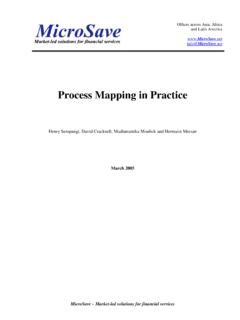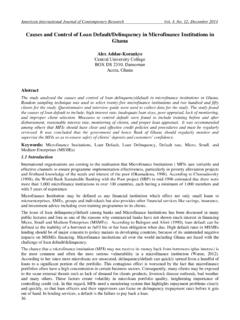Transcription of Strategic Marketing for MicroFinance Institutions
1 MicroSave Market-led solutions for financial services Offices across Asia, Africa and Latin America Strategic Marketing for MicroFinance Institutions Graham Wright, David Cracknell, Leonard Mutesasira and Rob Hudson March 2005 Strategic Marketing for MicroFinance Institutions - Graham Wright, David Cracknell, Leonard Mutesasira and Rob Hudson MicroSave Market-led solutions for financial services 1 Strategic Marketing for MicroFinance Institutions Graham Wright, David Cracknell, Leonard Mutesasira and Rob Hudson As more players enter the market and competition increases, MicroFinance will inevitably move away from the supply-led approach that applied a narrow range of lending methodologies to a wide range of contexts, towards a demand-driven, client-oriented approach. - CGAP Phase III Strategy 2003-2008 Introduction: MicroFinance has demonstrated its potential to assist the poor to make significant strides towards reducing their vulnerability, improving their livelihoods, paying for basic health care and financing their children s education (Littlefield et al.)
2 , 2003). Many MicroFinance Institutions (MFIs) have demonstrated an ability to provide financial services to poor people on a sustainable, profitable basis. Together, these facts have attracted a great deal of donor of money and a wide variety of organisations into the MicroFinance sector. As a result, a growing number of markets are becoming extremely competitive and clients have an ever-widening choice of financial service providers to choose from. With the vast majority of MFIs functionally confined to offering short-term credit products, the clients are effectively given the choice of staying with or leaving their current service provider at the end of every loan cycle. In competitive markets they are exercising this choice with unflinching regularity .. and many are deserting their service provider to try another or simply to take a rest from the rigours of MFIs terms and conditions.
3 The extensive literature documenting the reasons for and cost to MFIs of high levels of drop-out , exit or desertion (see for example Hulme et al., 1999, Wright 2000, Brand and Gershick, 2000) has spurred them to re-examine their products and delivery systems to respond better to clients needs. Furthermore, the growth in competition between MFIs in many markets has meant that growing numbers of MFIs are responding by seeking to better understand their clients demands and preferences and thus taking a market-led approach to their business (Anyango, Sebtsad and Cohen, 2002). The development of a more client-responsive, market-led approach to MicroFinance is an important watershed in an industry hitherto largely dominated by the misconception that simple replication of successful models could achieve massive and sustainable scale worldwide.
4 As Hulme notes, Ironically it is the success of the first wave finance for the poor is the greatest obstacle to future experimentation (Hulme, 1995 quoted in Rogaly, 1996). For most MFIs responding to the market has been largely in terms of developing new products that meet the needs of their clients. But some others are beginning to move towards a Strategic Marketing approach that looks at corporate branding and identity as well as product delivery system and customer service strategies in addition to the product strategy. There are many benefits in doing this for both the MFIs and their clients. For the MFI a market-led approach enhances customer loyalty and reduces drop-outs and thus increases profitability (Churchill and Halpern, 2001). For the MFIs customers more appropriate, client-responsive products allow them to better manage their household finances with a variety of financial services and products, in which they have confidence, delivered through systems and people that are secure, efficient and satisfying.
5 Strategic Marketing for MicroFinance Institutions - Graham Wright, David Cracknell, Leonard Mutesasira and Rob Hudson MicroSave Market-led solutions for financial services 2 Why a Market Orientation? Extracted from Gary Woller, 2002 Market orientation holds that success will come to those organizations that best determine the perceptions, needs, and wants of target markets and satisfies them through the design, communication, pricing, and delivery of appropriate and competitively viable offerings. 1 In contrast to a market orientation, most MFIs possess a product orientation, which holds that success will come to those organizations that bring to market goods and services they are convinced will be good for the public. 2 The transition from product orientation to market orientation is a process that has occurred in virtually all mature industries.
6 The MicroFinance industry is unique only in that it relatively young and immature, and it has yet to pass through this phase. But pass through this phase it must, if it is to survive and prosper. The question for MFIs is how to take an abstract concept like market orientation and give it real managerial/operational relevance. Of 48 studies testing the relationship between market orientation and institutional performance, 44 found positive relationship between market orientation and at least one measure of institutional performance as measured by profitability, sales, market share, or innovation success. The same studies also found positive relationships between market orientation and other organizational variables, such as customer retention, customer service, esprit de corps, trust in senior management, job satisfaction, and the intent to remain at an institution.
7 The weight of these empirical findings offers conclusive evidence that higher levels of market orientation lead generally to higher levels of institutional performance. Implications for MicroFinance The implications of the market orientation research for MFIs are many: Market orientation is by extension an important determinant of MFI performance ( , financial self-sufficiency, revenue growth, customer desertion, repayment rates, etc.) The best way to achieve long-term financial self-sufficiency and achieve deep outreach is to identify the needs and wants of the very poor and to provide products of value to them. To the extent MFIs explicitly target the very poor and create learning Institutions in tune with their needs and wants, competition and the drive for sustainable competitive advantage will drive MFIs to find ways to serve the very poor in an increasingly cost-effective manner.
8 The creation of a market-oriented institutional culture and market-oriented institutional practices is the distinct responsibility of senior management. Without the explicit and active participation of management (in both word and deed), the transition to market orientation will fail. The creation of an appropriate customer-centered reward system is an integral component of the transition to market orientation. It is an unambiguous statement of managerial values that connect rhetoric to practice. Other market-oriented practices include monitoring customer satisfaction and otherwise routinely soliciting customer feedback, hiring staff with customer-centered attitudes and firing those without, increase interaction and decrease conflict between functional departments, or pushing the decision-making locus closer to the customer.
9 The MicroFinance industry is beginning to mature, and with maturity comes change. There are four alternative concepts on which organisations conduct their activities these represent the development of Marketing philosophy. The concepts have characterised the maturation of most industries over time, and are also clearly discernable in the MicroFinance industry. The process of maturation has typically (but not always) been linear with the industry passing through each phase before moving to the next. These concepts for organisational activities are: Production: which focuses on producing goods/services as cheaply as possible; Product: which focuses on making the goods/services as high quality as possible; 1 Kotler, P. and Andreasen, (1996) 2 Kotler P. and Andreasen , (1996) Strategic Marketing for MicroFinance Institutions - Graham Wright, David Cracknell, Leonard Mutesasira and Rob Hudson MicroSave Market-led solutions for financial services 3 Selling: which focuses on persuading potential customers to buy the goods/services being produced; and Marketing : which focuses on understanding the target market(s) needs and responding to these in all aspects of the organisation s operations.
10 Table 1. Development of Marketing Philosophy The Marketing concept takes an outside-in perspective. The organisation tries to see itself from the client s perspective, and base its decisions (subject to financial and organisational constraints) on this perspective. Organisations using the Marketing concept recognise that there is more value in retaining customers than in attracting new customers who cost more. This concept works more at identifying and meeting customers needs profitably in addition to maximising customer satisfaction with existing products. Background to the Study: MicroSave reviewed the Marketing strategies of eight diverse Action Research Partners (ARPs) in collaboration with TMS Financial a Marketing company based in South Africa. These ARPs include a wide variety of organisations: NGO-MFIs (FINCA-Uganda and Uganda MicroFinance Union) Commercial banks (Centenary Rural Development Bank and Teba Bank) Government owned financial Institutions (Kenya Post Office Savings Bank and Tanzania Postal Bank) Non-bank financial Institutions (Equity Building Society and Credit Indemnity).














